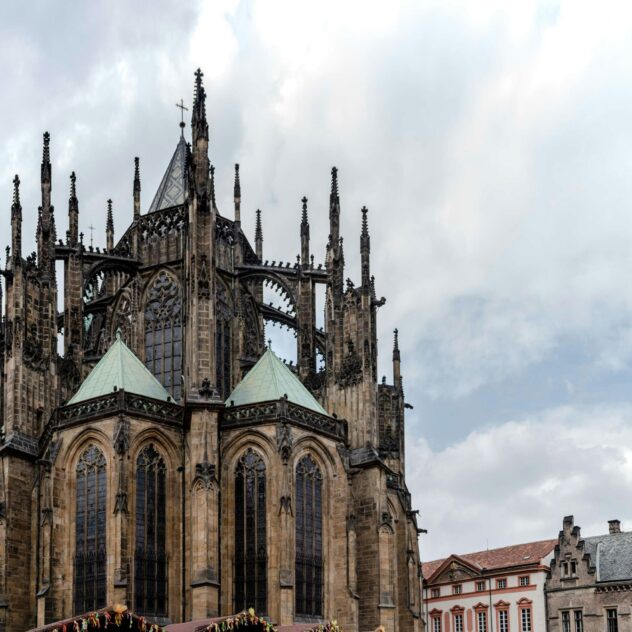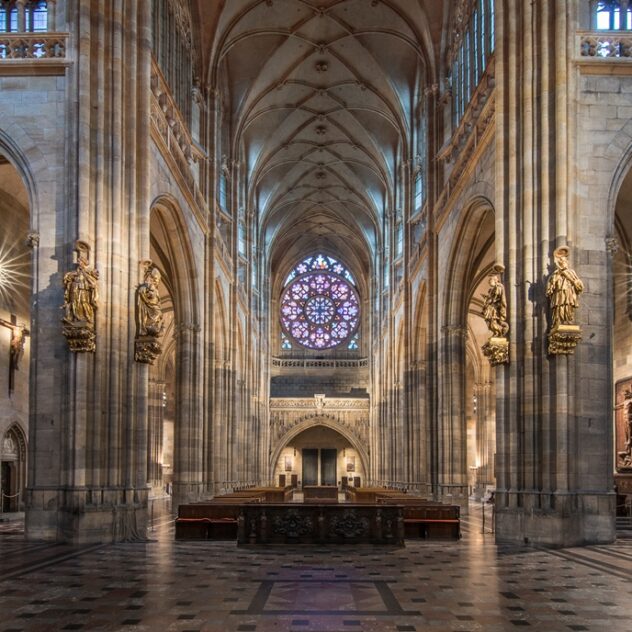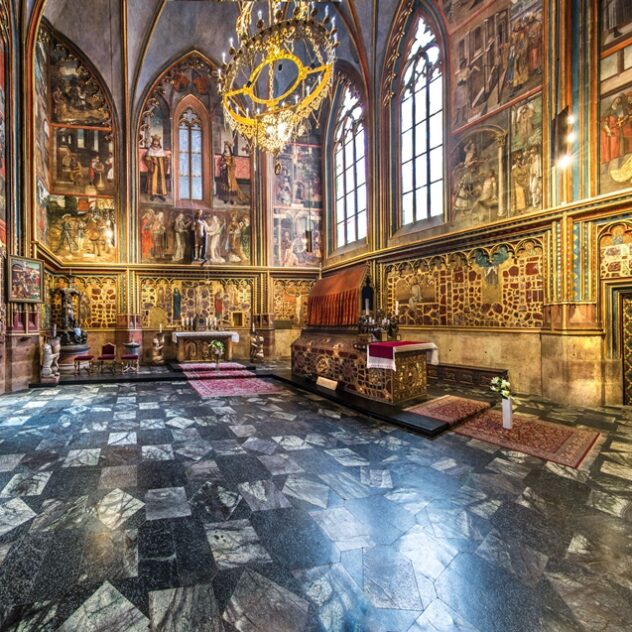Cathedral of St. Vitus, Wenceslas and Vojtech, Prague Castle, Prague
Information about the pilgrimage site
The Agnes Monastery Na Františku was founded in 1234 by the sister of King Wenceslas I, Princess Agnes. She brought the order of Poor Clares to the women’s monastery and the order of Minorites to the smaller men’s monastery. In the extensive grounds of the monastery there are two churches, the Church of St. Salvator and St. Francis, both dating back to the 13th century. Agnes first became abbess of the monastery and later served as a senior sister. She devoted her entire life to caring for the poor and sick, yet she was not canonized until the 20th century. The reason was that her relics were lost. Nevertheless, she was canonized by Pope John Paul II in 1989. Five days later, the Velvet Revolution began in the Czech Republic, thus fulfilling the old prophecy that the Czech Republic would be well after her canonization. More information at https://www.ngprague.cz/o-nas/budovy/klaster-sv-anezky-ceske .
Old Town Square is the most important square in the city centre and is a national cultural monument. This is the site of the old marketplace where most of the decisions about the affairs of the Czech country were made. Many important buildings, palaces and churches stand here. The Church of Our Lady before Týn, an important three-aisled Gothic building founded in 1365, is a rich treasure trove of Gothic and Baroque art. The Baroque Church of St. Nicholas is also significant. The most interesting tourist attraction is the Old Town Hall with its unique astronomical clock. It was built from several Gothic houses in the 14th century and was almost destroyed during the bombing in May 1945. The astronomical clock at the Town Hall was made in the early 15th century and consists of mechanical figures that appear in two windows at every full hour. The central part of the clock is occupied by a sphere measuring time and the youngest part of the clock is the calendar. For more information visit https://www.prague.eu/cs/objekt/mista/1174/turisticke-informacni-centrum-staromestska-radnice .
The Jewish town, also called the ghetto, developed and grew together with Prague. In the 19th century its walls and some buildings were demolished, but the most important monuments have been preserved to this day. Among them are the Old Jewish Cemetery from the mid-15th century, the Pinkas Synagogue built in the Gothic style, which is now a museum, the Old Synagogue from the 13th century, a two-aisle Gothic building which is one of the oldest buildings of its kind in Europe, the Maisel Synagogue, the Klaus Synagogue, the Spanish Synagogue and the Jewish Town Hall with the High Synagogue. For more information visit https://www.praha.eu/jnp/cz/co_delat_v_praze/pamatky/zidovske_mesto/index.htmlhttps .
Vyšehrad was built by the Přemyslid princes on the right bank of the Vltava River as their original royal residence. King Vratislav II founded a chapter here in 1070. Even Emperor Charles IV paid attention to this seat, but later the importance of the place declined. During the Hussite wars Vyšehrad was plundered and in the 17th century it was rebuilt into a Baroque military fortress. The oldest monument of the Vyšehrad complex is the rotunda of St. Martin from the 11th century. The dominant feature of Vyšehrad is the Chapter Church of St. Peter and Paul. Originally a Romanesque basilica from the time of King Vratislav I, it has been rebuilt several times. Today’s appearance is the result of reconstruction by the architect Josef Mocker from 1885-87 in the Neo-Gothic style. The interior is in the Art Nouveau style, the Gothic panel painting of the Virgin Mary called Rain from the 14th century is worth noticing. The significance of this historical site is underlined by the illuminated Romanesque Codex of Vyšehrad. Pilgrimages and devotions.
The dancing house is very popular with tourists. It was completed on the riverbank in 1996 by architects Frank Gehry and Vlad Mulinich. It was inspired by the famous dancing couple Ginger Rogers and Fred Astaire. The building houses a hotel, café, offices and exhibition space. For more information, visit https://www.prague.eu/cs/objekt/mista/1643/tancici-dum .
Prague Zoo is the fifth best in the world. It is located in Prague’s Troja district, 7 km from the city centre and covers 58 hectares in a unique natural environment. Founded in 1931, it is also close to the Botanical Garden and the beautiful Baroque Troja Castle. For more information visit https://www.zoopraha.cz/ .
Other tourist attractions in the area can be found on the website:
https://www.praha.eu/jnp/cz/co_delat_v_praze/pamatky/index.html
https://www.strednicechy.cz/?gad_source=1&gclid=EAIaIQobChMIiOObp5HHhQMVk42DBx3wCAPjEAAYASAAEgKlQ_D_BwE
Tourist attractions in the vicinity
The Agnes Monastery Na Františku was founded in 1234 by the sister of King Wenceslas I, Princess Agnes. She brought the order of Poor Clares to the women’s monastery and the order of Minorites to the smaller men’s monastery. In the extensive grounds of the monastery there are two churches, the Church of St. Salvator and St. Francis, both dating back to the 13th century. Agnes first became abbess of the monastery and later served as a senior sister. She devoted her entire life to caring for the poor and sick, yet she was not canonized until the 20th century. The reason was that her relics were lost. Nevertheless, she was canonized by Pope John Paul II in 1989. Five days later, the Velvet Revolution began in the Czech Republic, thus fulfilling the old prophecy that the Czech Republic would be well after her canonization. More information at https://www.ngprague.cz/o-nas/budovy/klaster-sv-anezky-ceske .
Old Town Square is the most important square in the city centre and is a national cultural monument. This is the site of the old marketplace where most of the decisions about the affairs of the Czech country were made. Many important buildings, palaces and churches stand here. The Church of Our Lady before Týn, an important three-aisled Gothic building founded in 1365, is a rich treasure trove of Gothic and Baroque art. The Baroque Church of St. Nicholas is also significant. The most interesting tourist attraction is the Old Town Hall with its unique astronomical clock. It was built from several Gothic houses in the 14th century and was almost destroyed during the bombing in May 1945. The astronomical clock at the Town Hall was made in the early 15th century and consists of mechanical figures that appear in two windows at every full hour. The central part of the clock is occupied by a sphere measuring time and the youngest part of the clock is the calendar. For more information visit https://www.prague.eu/cs/objekt/mista/1174/turisticke-informacni-centrum-staromestska-radnice .
The Jewish town, also called the ghetto, developed and grew together with Prague. In the 19th century its walls and some buildings were demolished, but the most important monuments have been preserved to this day. Among them are the Old Jewish Cemetery from the mid-15th century, the Pinkas Synagogue built in the Gothic style, which is now a museum, the Old Synagogue from the 13th century, a two-aisle Gothic building which is one of the oldest buildings of its kind in Europe, the Maisel Synagogue, the Klaus Synagogue, the Spanish Synagogue and the Jewish Town Hall with the High Synagogue. For more information visit https://www.praha.eu/jnp/cz/co_delat_v_praze/pamatky/zidovske_mesto/index.htmlhttps .
Vyšehrad was built by the Přemyslid princes on the right bank of the Vltava River as their original royal residence. King Vratislav II founded a chapter here in 1070. Even Emperor Charles IV paid attention to this seat, but later the importance of the place declined. During the Hussite wars Vyšehrad was plundered and in the 17th century it was rebuilt into a Baroque military fortress. The oldest monument of the Vyšehrad complex is the rotunda of St. Martin from the 11th century. The dominant feature of Vyšehrad is the Chapter Church of St. Peter and Paul. Originally a Romanesque basilica from the time of King Vratislav I, it has been rebuilt several times. Today’s appearance is the result of reconstruction by the architect Josef Mocker from 1885-87 in the Neo-Gothic style. The interior is in the Art Nouveau style, the Gothic panel painting of the Virgin Mary called Rain from the 14th century is worth noticing. The significance of this historical site is underlined by the illuminated Romanesque Codex of Vyšehrad. Pilgrimages and devotions.
The dancing house is very popular with tourists. It was completed on the riverbank in 1996 by architects Frank Gehry and Vlad Mulinich. It was inspired by the famous dancing couple Ginger Rogers and Fred Astaire. The building houses a hotel, café, offices and exhibition space. For more information, visit https://www.prague.eu/cs/objekt/mista/1643/tancici-dum .
Prague Zoo is the fifth best in the world. It is located in Prague’s Troja district, 7 km from the city centre and covers 58 hectares in a unique natural environment. Founded in 1931, it is also close to the Botanical Garden and the beautiful Baroque Troja Castle. For more information visit https://www.zoopraha.cz/ .
Other tourist attractions in the area can be found on the website:
https://www.praha.eu/jnp/cz/co_delat_v_praze/pamatky/index.html
https://www.strednicechy.cz/?gad_source=1&gclid=EAIaIQobChMIiOObp5HHhQMVk42DBx3wCAPjEAAYASAAEgKlQ_D_BwE
Accommodation
- For affordable accommodation, you can contact the Capuchinate, which offers accommodation for pilgrims and tourists. For more information, visit https://kapucinat.kapucini.cz/
- The capital city of Prague offers a very diverse range of commercial accommodation in hotels, guesthouses or hostels.
Availability
By car
St. Vitus Cathedral is located in the centre of Prague and is accessible by car to the entrances to the Prague Castle grounds, but parking options are limited.
By public transport
The site is accessible by Prague’s integrated transport, the nearest tram stop is Na Pohořelci or Malostranská.
On foot
The place is very accessible on foot. More information is on the homepage.
On a bicycle
The cathedral is accessible on bicycles, but it is not possible to pass through the Prague Castle.








